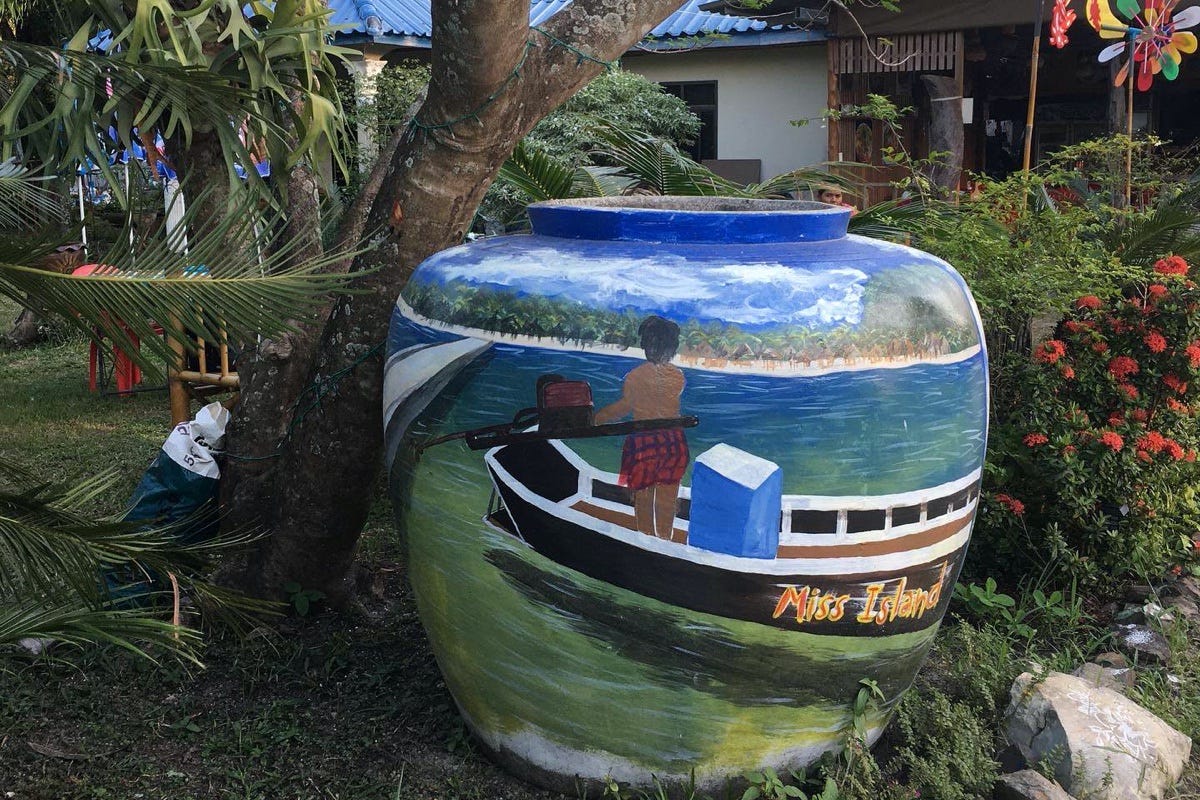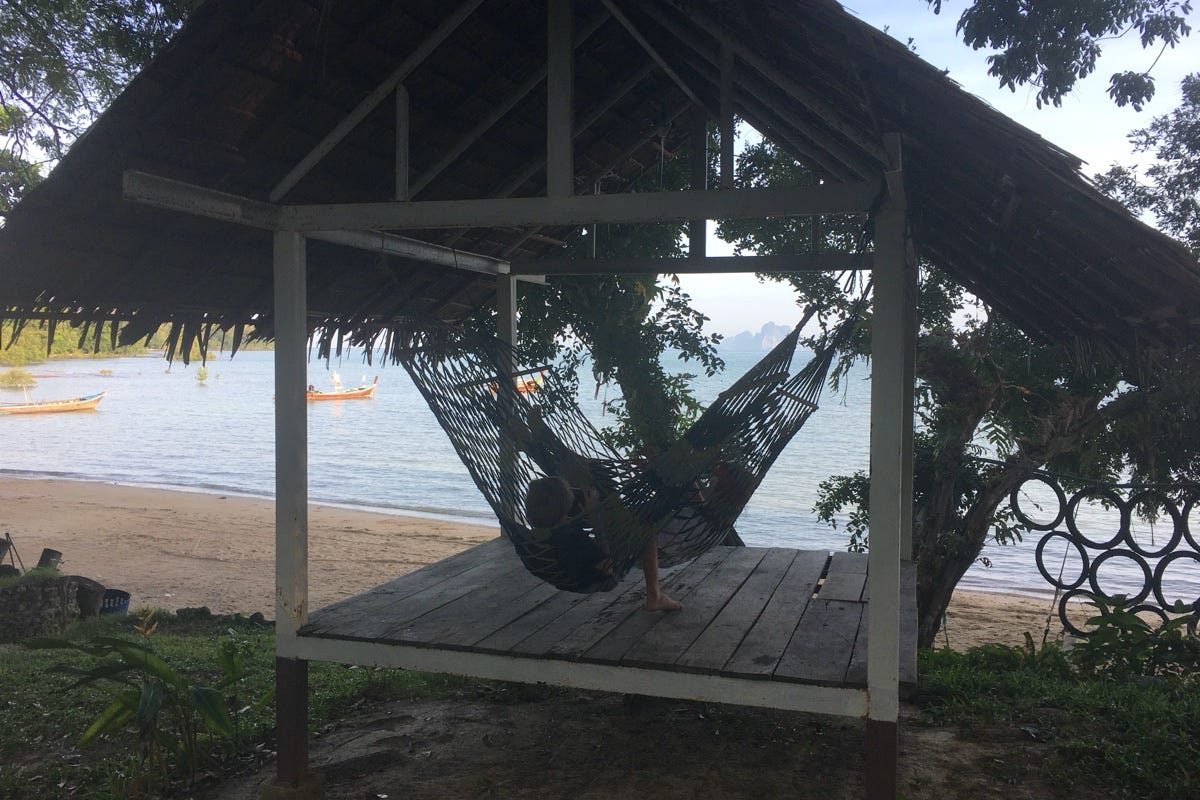Across our few days on Ko Kradan, we spent our fair share of time watching the sinking sun’s rays garnish Ko Muk’s peaks. The island is famous for being home to the Emerald Cave, but has also long been the backpacker island of choice in the area. Both my wallet and I are keen to get there and a morning longtail is in order.
Changing planets. Photo: Stuart McDonald.
Much as when we arrived, the sea is glassy as we chug back across. Chug being the active word as the longtail is the slowest one I’ve even ridden on. Even the kids roll their eyes. Much as we came, we skirt around the southern tip of Ko Muk, past the white sand spur then across seagrass fields to the pier.
Unlike Ko Kradan, Ko Muk is a “living island”. There are real villages here and local islanders have lived on the island for generations. Before the first backpackers arrived, fishing and tapping rubber were their main gigs. Today, despite the island hosting dozens of places to stay, tourism remains an afterthought for many.
Welcome to Ko Muk. Photo: Stuart McDonald.
This “being an afterthought” is a large part of the appeal. The island doesn’t have the “tourist plaything” vibe of Ko Kradan—instead you feel like a guest. A feeling greatly assisted by the welcoming vibe the island’s people emanate.
As with a number of other islands on this coast, the locals are predominantly Muslim. On the main beach on the far side of the island, you might miss this, but we don’t—we’re staying on the village side. After walking down the long wharf, we wander along a narrow village path to find our digs. On the sea–side of the path there’s stilted wooden family houses over the water. Kids kick a ball, head–scarfed women chat and smile as we pass.
Walking through the village—there is always a motorbike. Photo: Stuart McDonald.
“Sawatdee Kah,” they say to us, the kids try to reply, but stumble on the phrase, and everyone laughs. Ko Muk is that kind of a place.
The resort is not great. On arriving we discover a guest is in the room we booked and is refusing to move out. He prolonged his stay that morning and doesn’t want to move. It is a mix–up, but he’s in a two floor house I’d booked specifically—we’re a travelling threesome, to be a foursome in a few hours. He won’t budge.
The resort offers an alternative—two adjoining concrete rooms instead of the house. They’re apologetic—it is their error—but I’m baffled by the foreigner’s attitude. We settle for the concrete boxes and will move in when Mr Stubborn leaves the next day. The whole exchange takes the edge off the smiling women in the village. Bloody tourists.
A fishing island with a sideline in tourists. Photo: Stuart McDonald.
The resort is old. One of those places that has grown organically over the last twenty years or so. Every spurt of growth in a different direction and style. Sitting on the veranda, I look across the hodgepodge of rooms. It is easy to see which are the oldest rooms—we’re in the newest, but they are utterly devoid of charm. In the centre a decent–sized pool pleases the kids, but, like the rooms, it doesn’t fit in with anything.
The only part that does work are the lush gardens—nature will not be messed with. By the tumbledown edge to the sea, there are a few huge shade trees, hammocks pre–slung.
We walk into the village proper. It is that early afternoon heat where the only people stupid enough to be out and about are tourists like us. Planning on roti and coffee, the stall is untended, a woman asleep on the floor behind it. I leave her in peace and we wander further up for a simple one plate lunch. While we sit, foreigners pass by, some on foot, others on scooters, but the vibe is low key.
Dingle dangle. Photo: Stuart McDonald.
After lunch, we continue through the village to the south side, where the village once again meets the sea. Along here there are a gaggle of sleepy beach bars. Business is dead—things won’t pick up till later in the afternoon, but we’re still greeted with a smile. As with the resort, there’s a large shade tree overhanging the scrappy beach. Glass bottles house candles and dingle dangle from the branches.
It is hot. Very hot. The three of us sit there in low chairs, enjoying the slightest of breeze off the water. Our drinks come. Water for Will, iced tea for Lyla and a soda for me. We sit there, in silence, slurping. There’s not another guest at the cafe, and save a couple who stroll past, it is like we’ve our own strip of beach. As the heat eases, and light begins to fade, we walk back.
No Minecraft required. Photo: Stuart McDonald.
Once there, the kids and I swing and swim. Mum is due to arrive in the next hour or so. She’s joining us for a few days over New Years from Bali. While we float, she’s in a taxi from Hat Yai—we bet each other as to the hour she’ll arrive.
Later, in hammocks overlooking the water we gaze out. The tide ebbs, seeping out to reveal mudflats and the remnants of mangrove roots. Locals wander the shallows picking out shellfish and aluminium cans. The sun sinks and longtails buzz by out to sea.



















Share this post